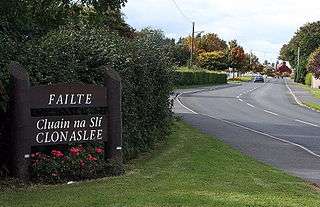Clonaslee

Clonaslee (Irish: Cluain na Slí) is a village in north County Laois, Ireland, situated in the foothills of the Slieve Bloom Mountains on the R422 Mountmellick to Birr road. located some 100 km west of Dublin. The name means "meadow of the way", the way referred to having once been an important cross-country route. The Slí Dála is an ancient road, thought to lead to Tara, which passes through this area. This is said to be the origin of the name Cluain na Slí, or Clonaslee.
Places of interest
Local attractions include: Brittas Lake, Brittas Castle (which is currently being renovated by a private owner), Slieve Bloom Forest Park,The Giants Grave and many forest walks with some beautiful scenery. Clonaslee is close to the towns of Portlaoise and Tullamore. Although a number of archaeological finds in the area indicate the presence of settlements in the area from the Neolithic period, the modern day Clonaslee has evolved from its beginnings as an Anglo-Norman town of the late-12th century. At this time the eskers and related landforms gave a great strategic advantage by providing ideal vantage points where mottes and other defensive battlements were constructed. This advantage also had a profound influence on the location of towns and villages throughout the county. From the 12th to 17th centuries, recorded history does not provide much detail on the development of Clonaslee. The most significant period in the village's growth undoubtedly took place from the 16th century under the influence of the Dunnes of Brittas.
This family left their mark on the form and history of the village as evidenced in its planned form and also from a number of ruins in the area. The former residence of a young branch of the family remains in ruins one mile from the village at Clara Hill. Also, near the east bank of the Clodiagh River stand the ruins of Ballinakill Castle, built in 1680 by Colonel Dunne. Throughout the 18th century, Clonaslee prospered due to its location on an important highway across Laois leading onto Munster. The proximity of Brittas - the seat of the Dunnes - was also influential as the power of this family had by now grown beyond that of a native Irish Chieftain. In 1771, Francis Dunne, then head of the Dunne Family, became a Roman Catholic and built a thatched parish chapel in the village. This was located close to the site of the present church.
The Dunne family continued to finance the construction of landmark buildings in the village. The parish Church was erected in 1814 under General Dunne (known locally as 'shun-battle Ned' because of his rumoured refusal to fight at the 1815 Battle of Waterloo). The construction of the Church was aided by a gift of £800 and a loan of £300 from the former Board of First Fruit. In 1830, the same board donated £50 towards the construction of Glebe House. The village continued to grow quickly from the 1800s to the 1830s. This was largely due to the development of the Mountmellick to Birr road in 1814. This period also saw the arrival of civic facilities such as the Post Office, the Police Station and other offices of Civil Administration. The population of the village peaked at 561 inhabitants in 1841. However, in 1901 this fell to a low of 287 persons.
Provisional statistics from the 2002 Census indicate the population of the Clonaslee Electoral Division increased from 830 persons in 1996 to 883 persons in 2002.
Sport
- Clonaslee-St.Manmans is the local Gaelic Athletic Association club.
External links
Coordinates: 53°09′N 7°31′W / 53.150°N 7.517°W